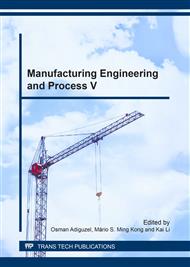[1]
J. K. Buttner, R. W. Soderberg, D. E. Terlizzi, An introduction to water chemistry in freshwater aquaculture, NRAC Fact Sheet No. 170-(1993).
Google Scholar
[2]
W. –Y. Chung, J. –H. Yoo, Remote water quality monitoring in wide area, Sensor. Act. B., 217 (2015), p.51 – 57.
Google Scholar
[3]
Total dissolved solids in Drinking-water, Background document for development ofWHO Guidelines for Drinking-water Quality, World Health Organization, Geneva, (2003).
Google Scholar
[4]
L. Parra, S. Sendra, J. Lloret, I. Bosch, Development of a conductivity sensor for monitoring groundwater resources to optimize water management insmart city environments, Sensors, 15 (2015), p.20990 – 21015.
DOI: 10.3390/s150920990
Google Scholar
[5]
M. Sophocleous, J. K. Atkinson, A novel thick-film electrical conductivity sensor suitable for liquidand soil conductivity measurements, Sensor. Act. B., 213 (2015), p.417– 422.
DOI: 10.1016/j.snb.2015.02.110
Google Scholar
[6]
D. L. Corwin, S. M. Lesch, Apparent soil electrical conductivitymeasurements in agriculture, Comp. Elec. in Agri., 46 (2005), p.11–43.
Google Scholar
[7]
P. M. Ramos, J. M. D. Pereira, H. M. G. Ramos, A. L. Ribeiro, A four terminal water quality monitoringconductivity sensor, IEEE Tran. Instr. Meas., 57, 3 (2008), p.577 – 583.
DOI: 10.1109/tim.2007.911703
Google Scholar
[8]
G. Liu, C. Ho, N. Slappey, Z. Zhou, S.E. Snelgrove, M. Brown, A. Grabinski, X. Guo,Y. Chen, K. Miller, J. Edwards, T. Kaya, A wearable conductivity sensor for wireless real-time sweatmonitoring, Sensor. Act. B., 227 (2016), p.35 – 42.
DOI: 10.1016/j.snb.2015.12.034
Google Scholar
[9]
J. K. Atkinson, M. Glanc, M. Prakorbjanya, M. Sophocleous, R. P. Sion, E. Garcia-Breijo, Thick film screen printed environmental and chemical sensor array reference electrodessuitable for subterranean and subaqueous deployments, Microelec. Int., 30, 2 (2013).
DOI: 10.1108/13565361311314485
Google Scholar
[10]
M. H. Banna, H. Najjaran, R. Sadiq, S. A. Imran,M. J. Rodriguez, M. Hoorfar, Miniaturized water quality monitoring pH and conductivity sensors, Sensor. Act. B., 193 (2014), p.434 –441.
DOI: 10.1016/j.snb.2013.12.002
Google Scholar
[11]
S. L. Schiefelbein, N. A. Fried, K. G. Rhoads, D. R. Sadoway, A high-accuracy, calibration-free technique for measuring the electrical conductivity of liquids, Rev. Sci. Inst., 69, 9 (1998), p.3308 – 3313.
DOI: 10.1063/1.1149095
Google Scholar
[12]
S. Zhuiykov, Solid-state sensors monitoring parameters of water quality for the nextgeneration of wireless sensor networks, Sensor. Act. B., 161 (2012), p.1 – 20.
DOI: 10.1016/j.snb.2011.10.078
Google Scholar
[13]
Y. Lin, Y. Peng, J. Di, Electrochemical detection of Hg(II) ions based on nanoporous goldnanoparticles modified indium tin oxide electrode, Sensor. Act. B., 220 (2015), p.1086–1090.
DOI: 10.1016/j.snb.2015.06.064
Google Scholar
[14]
T. Li, K. Ding, W. E. Seyfried, Jr., Y. B. Gianchandani, A micromachined chemical sensor for sea floor environments: Initial results, Tech. Dig. Sol. Sta. Sens., Act., Microsys. Works., (2012), p.173 – 176.
DOI: 10.31438/trf.hh2012.46
Google Scholar
[15]
X. Huang, M. C. Mowlem, R. Pascal, K. Chamberlain, C. Banks, H. Morgan, A miniature high precision conductivity and temperaturesensor system for ocean monitoring, IEEE Sens. J., 11, 12 (2011), p.3246 – 3252.
DOI: 10.1109/jsen.2011.2149516
Google Scholar
[16]
Conductivity theory and practice, Radiometer Analytical, France (2004).
Google Scholar
[17]
J. J. Barron, C. Ashton, The effect of temperature on conductivity measurement, http: /www. reagecon. com/pdf/technicalpapers/Effect_of_Temperature_TSP-07_Issue3. pdf, p.1 – 5.
Google Scholar


